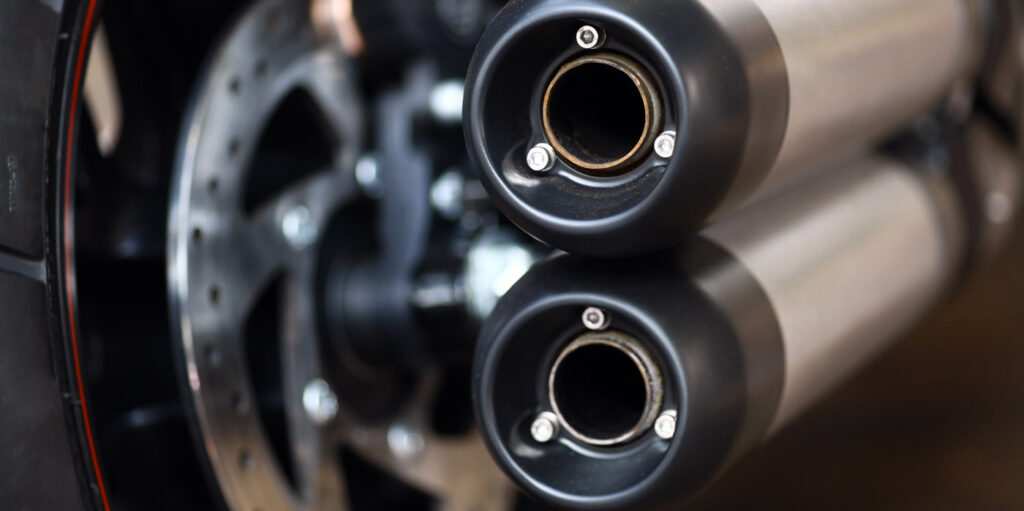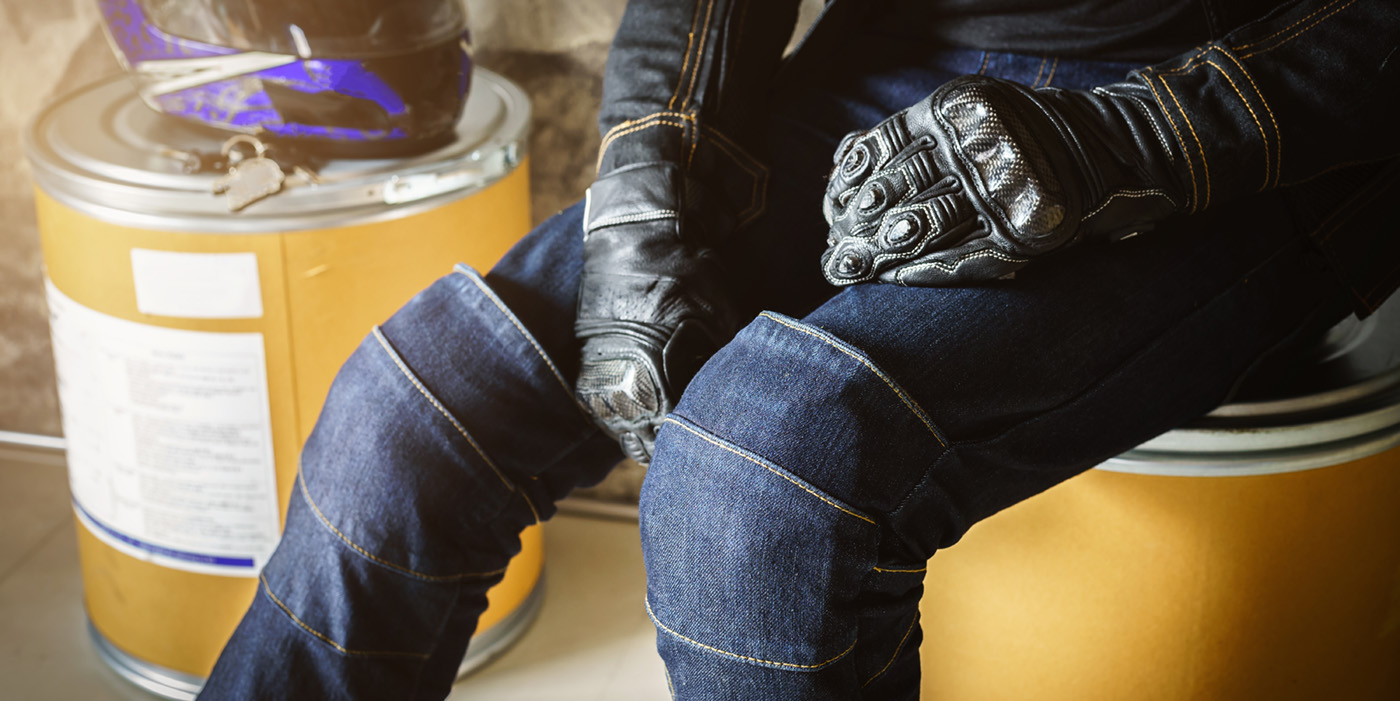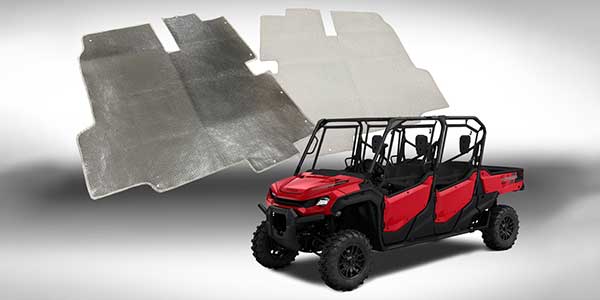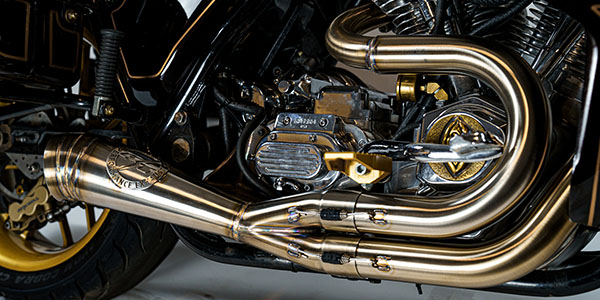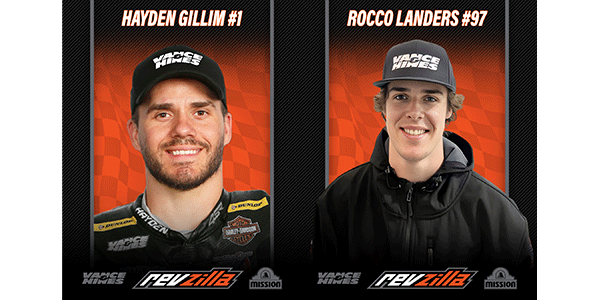Last week, I mentioned that some exhaust system manufacturers are working to lower emissions in their products. Others prioritize enhancing rider comfort with heat reduction. All of them want to get the right sound, but have to be aware of noise reduction regulations. These are three major aspects of exhaust system performance critical to riders, so let’s delve into each one.
Lowering Emissions
“A handful of manufacturers… are indeed building emissions-compliant performance exhaust. It’s certainly more complex and requires lab time and durability testing (CARB mandates 15,000 kilometers), but it’s very doable and the end result is an exhaust system that will see substantial gains in horsepower and torque,” says David Zemla, vice president of marketing for S&S Cycle.
Why only a “handful?” According to Tim Welch, sales manager for Yoshimura R&D of America, not only does it have to do with bureaucracy and the cost to manufacture emissions-compliant exhausts systems, but manufacturers must take into account demand as well. There’s a preexisting bias against emissions components, but this attitude — which I will discuss in detail in next week’s article — stems from a pervasive misconception.
“Everybody automatically assumes that an emissions component robs power, but that’s not the case,” Welch argues. “And in many cases, we find that part of the function of that emissions control system manages the efficiency of the motor, and with an efficient motor comes performance and power. Just to arbitrarily rip everything off your motorcycle that manages emissions because you think you’re going to get more power, you’re cutting your nose off to spite your face, because it’s not true.”
However, as both the EPA and localities regulate emissions, it’s going to become harder and harder to just “rip everything off.” As such, dealers need to step up and educate customers that there are aftermarket options available that remain emissions compliant and deliver the power they need.
“In California, you cannot touch a catalyst on a bike,” Danny Valencia, operations manager for Two Brothers Racing (TBR) notes. “That’s going to leave a huge clog in the system, which is going to greatly hinder your performance. For most of the world and most of the country, it’s not really a thing that is a huge concern. But, you are starting to see more people playing with the idea by using high-flow cats and trying to get these systems that need EPA requirements and still get numbers that are similar to aftermarket ones that open them up. It’s still a new area in the market right now that’s getting explored.”
The customer’s desire for more power — responsive acceleration off the line, getting a jump in passing a vehicle and extra torque — is precisely what some companies are aiming to achieve while balancing government regulations, says Mike Kennedy, CEO and president of Vance & Hines. “When it’s designed and engineering properly, you can actually improve the performance,” he notes.
But Kennedy says a full exhaust upgrade isn’t just about swapping out the pipes — it involves the tuner and air intake as well. “When a rider changes out the exhaust system and an air intake and it gets tuned, they refer to that as a Stage 1 upgrade,” he explains. Dealers should check to see if the exhaust systems, tuners and air intakes they stock are compliant in all 50 states — or at least 49 (minus California). This way, Kennedy says, “A rider now can shop with confidence and change out all three and still keep their warranty intact and improve the performance, style and the sound of the motorcycle.”
Heat Control
If you’ve ever been to Sturgis, you’ve likely felt the heat. Not only is it the height of summer, but depending on what bike you’re riding — if it’s stock, modified or custom — you might get off and feel like your legs are on fire. Stock exhausts, for instance, are clogged further up the pipe with a catalyst to retain more heat and better convert the gasses coming out. Even so, they still incorporate some form of heat reduction.
“For the most part, two-wheel exhaust systems utilize a shield over the main header. This is essentially a partial tube with an air gap between it and the main header. Even a quarter-inch of air gap will drop exhaust temps significantly enough for a rider to notice,” Zemla explains.
Valencia adds that the makeup of an exhaust system all depends on what the motor is used for. “Certain motors put out a lot more heat, so you’re going to use different materials to build it to handle the heat better.” For instance, he notes, since a side-by-side will push out a lot more heat, manufacturers will use more heavyweight materials that can handle that output versus the carbon fiber you might find on a sports bike.
Now, if you were to get a new exhaust system or open it up and get it tuned, the temperature would come down. But while exhaust manufacturers try to beat the heat and route the exhaust around the natural position of the leg, it’s not always possible, and that’s where heat shields come into play.
Heat shield liners are separate pieces of insulated material that are suspended between the heat shield and the exhaust pipe. This way, the exhaust can dissipate and deflect around the back side of the heat shield and not radiate directly to the rider’s legs.
“[These] kits use a combination of reflective dimpled aluminum and Dura 2000 insulating material to reduce heat radiating through the heat shields and towards the rider and passenger,” explains John Gabriel, powersports division manager, Design Engineering Inc. “Complete kits are available for popular stock and aftermarket exhaust systems. Universal cut-to-fit kits are available as well. The kits reduce felt heat and do not affect performance in any way.”
For motorcycles, you have the option to use heat shield liner kits or exhaust wraps; for sport bikes, there are also materials to protect body work from heat damage. For side-by-sides, there are custom kits that install inside of the interior panels to reduce heat radiating into the vehicle. The materials used can vary depending on area and amount of heat.
“With the exhaust system manufacturers beginning to offer more applications with catalytic converters, we will see heat and rider comfort remain as an area of interest,” Gabriel affirms.
Noise Reduction
Noise is a very personal part of the motorcycle/powersports experience — and a very subjective one. Every rider has a different notion of what’s too soft or loud, what level of rumble is best and more. Traditionally, there’s been this idea that “louder is better,” or “loud pipes save lives,” but with more and more riding happening in urban areas and municipalities putting up noise restrictions, exhaust manufacturers are having to balance pleasing the customer without upsetting the neighbors/locality, who can ticket high-noise offenders. Noise regulation is becoming an issue in Europe especially. “The days of wide-open exhaust are probably behind us,” Zemla remarks.
But exactly what part of the exhaust system makes the sound? It’s kind of a trick question. The sound actually begins with the motor. “You’re never going to get a ZX-6 to sound like an R1. It never will because the engine is completely different,” Valencia says. But it’s everything that comes after the motor that tunes the precise note of the sound. The system as a whole is meant to manipulate the amplitude and tone.
“The entire header is key to sound,” Zemla notes. “A header can have steps in tubing size that will change the exhaust note, and a muffler may have a perforated or louvered-style baffle as well as the potential of packing. Off-road exhaust that has more real estate will use a larger body and internal chambers to control sound.”
However, if the engine determines the rumble, the muffler determines its pitch.
“The muffler is what makes the major difference in reducing noise levels people hear coming from an exhaust system,” Welch explains. “We can restrict them up to the point where you don’t really hear anything out of the exhaust anymore. At that point, most of the noise we hear is gear noise and internal mechanical noise from the motor, which is what most stock motorcycles sound like. When we put an aftermarket exhaust pipe on it, we’re removing some restriction to enhance the sound.”
The makeup of the muffler itself also comes into play. For instance, a note will sound different depending on what core is used inside the muffler: standard proof core, spiral proof core or louver core. Furthermore, Kennedy says, “The baffle design drives the majority of the tonal quality from the muffler.”
“Mufflers with tunable inserts are the ideal solution for satisfying a larger customer base,” Zemla concludes.

